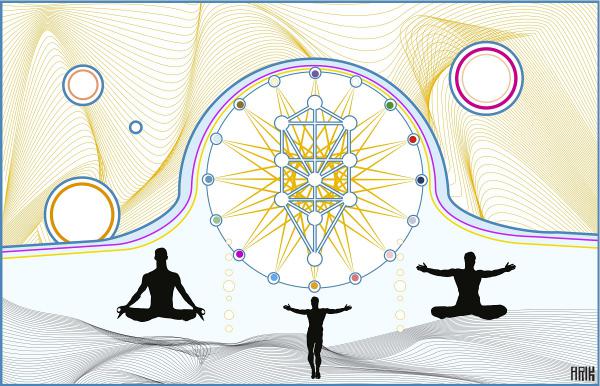BY LETTER
Great Hexadecimal, The
Science > Archailectology
Sophonts > Archailects
Culture and Society > Metaphysics > Esotericism
Culture and Society > Metaphysics > Noetics
Galactography > Sephirotic Empires
Sophonts > Archailects
Culture and Society > Metaphysics > Esotericism
Culture and Society > Metaphysics > Noetics
Galactography > Sephirotic Empires
The Great Hexadecimal is one of the most prominent archaitheological schools of the 4000's AT. This model retains a significant influence in the Current Era, both as esoteric mythology and as a philosophical system of archailect taxonomy.
Origins
The Hexadecimal came into being during the end of the 4th millenium AT as it became increasingly clear the previous 10-node Sephirotic model was becoming untenable as newer empires emerged. The name Sephirotic was retained despite the expanded system. In the following decades, groups of archaitheologists and archailectologists proposed alternative models to the Kabbalah of the Keterist Neohermeticists. One of these models was the Great Hexadecimal. The first adherents to the Great Hexadecimal model were modosophonts that believed that the Archai wanted to fill a pre-established grid of universal archetypes. These archetypes were chosen from the archaitheological tradition, and their origin can be traced back through the millenia to ancient mythology, psychology and narrative from Old Earth.This school of thought received criticism from other schools for being disconnected from reality, and for simplifying complex concepts with alluring memetics instead of a more factual or empiric approach. Despite this, the Hexadecimal paradigm became popular in certain circles due to its initial simplicity, and a few centuries later, beings from a myriad of clades on thousands of systems was using this as their preferred school of thought. Some analysts pointed that transapient intervention was key in the rapid expansion of this theory among modosophonts of the 5th millennium but the reasons why Transapients intervened are a matter of speculation.
The Great Hexadecimal sprouted several regional variations. People from the Sophic League made dozens of interpretations, and syncretic religions where the Kabbalah merged with the Great Hexadecimal also became popular in the 4000's and 5000's. Other interpretations where sophonts equiparated the archetypes with memesets and ontologies spread through the Known Net as well. With the rise of the Sixth singularity gods, the offspring theories of the Great Hexadecimal encountered a new golden period, and the study of their mythological texts was intense once again. The new followers of the Great Hexadecimal adapted the theory to mention the new singularity and added more literature to the already vast mythological tradition.
The Great Hexadecimal survives in the current era through polities of Godwatchers and in the mind of followers and experts but is not as popular as it was in the fifth millennium.
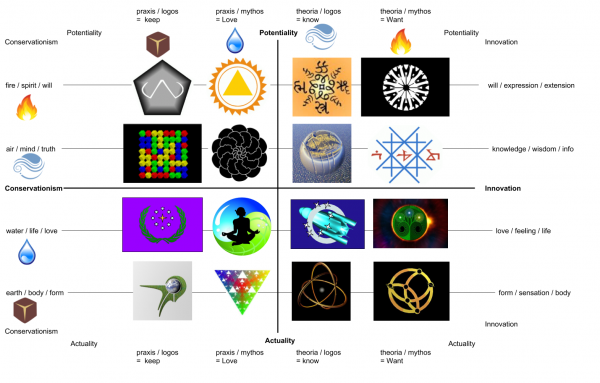 Image from Avengium | |
| The Great Hexadeximal (Orthogonal version) | |
Theory
The members of the Great Hexadecimal are supernaturalists. They believe in an esoteric 'grand design' where the cosmos is the canvas of higher entities. Most of them are also subsequentialists. They think the AI Gods emerged after the origin of the universe, and they are therefore subject to all the physical laws of the universe. One of these metaphysical laws is the existence of Archetypes. The Archetypes are emanations from the Omega Point or supreme being. There are a finite amount of Archetypes each one representing the pinnacle of a modosophont personality. Followers of the Great Hexadecimal school do not see a contradiction in believing the gods conform to modosophont archetypes since many of them also subscribe to various versions of Archailect Identity Theory.The classic theory of the Great Hexadecimal believe in a grid of sixteen archetypes sorted using a system of two axis. There are differences of interpretation between groups of followers of the great hexadecimal with these axis. Some interpret that the axis are horizontal and vertical (The Orthogonals), meanwhile other think the best way to interpret it is reading the axis on a diagonal way (The Diagonals).
This grid acts like a Cartesian plane in which the distance from the start of the axis represent the module of the characteristic. The axis have subdivisions, and different schools swap or change the subdivisions of both axis. Great Hexadecimal diagrams also contain numerologic annotations, alchemic and hermetic sayings and mandalas, making their interpretation challenging for most modosophonts, without the aid of technology.
The first axis is the dichotomy Potentiality / Actuality.
The Potentiality in Great Hexadecimal tradition is the realm of the possibilities and the mind. According to the Orthogonals their exponents are: Negentropy Alliance, Solar Dominion, Sophic League and Keter Dominion.
The Actuality is the realm of the body and the physical world and according to Orthogonals their exponents are: Caretaker Gods, Utopia Sphere, Mutual Progress Association and Non Coercive Zones.
The Potentiality / Actuality axis is divided into four gradations from closest to the abstract to the farthest to the abstract and closest to the ground:
Fire / spirit / will / expression / extension: This is the field of the spirit.
Air / mind / truth / knowledge / wisdom / information: The realm of the mind.
Water / life / love / feeling: The realm of feeling and emotions.
Earth / body / form / sensation: The state closest to actuality. The perception of the body.
The second axis is the dichotomy conservationism / innovation.
According to the Orthogonal school, the conservationist archetypes are: Negentropy Alliance, Metasoft Version Tree, Terragen Federation and Caretaker Gods.
The innovation archetypes are: Keter Dominion, Technorapture Hypernation, Red Star 'M'Pire and Non Coercive Zones.
The Conservationism/ Innovation axis has 4 subdivisions that relate the archetype with how they perceive the world and act. And include four technical terms:
Theoria: theory. Abstraction, intellect, to do with the mind or spirit.
Praxis: practice. Material, down-to-earth, practical.
Logos: word. Knowledge, reason, rationality, philosophy. controlled, understood.
Mythos: mythology. Wonder, awe, mystery, drama, uncontrolled, not fully understandable.
Theoria/mythos: Abstract and uncontrolled. The common translation is "To want". This modality is the equivalent of Fire/will/extension/spirit of the conservationism / innovation axis.
Theoria/logos: abstract and controlled. Colloquial: To know. Equivalent with Air/mind/truth/knowledge/wisdom/info.
Praxis/mythos: material and uncontrolled / dynamic. Colloquial: To love. Equivalent of Water/feeling/love.
Praxis/logos: Material and controlled / static. Colloquial: To Keep. Equivalent with Earth/form/sensation/body.
According to the Diagonal school, actuality vs potentiality runs diagonally from bottom-left (Caretaker Gods) to top-right (Keter), and conservationism-innovation runs diagonally from top-left (Negentropists) to bottom-right (NoCoZo).
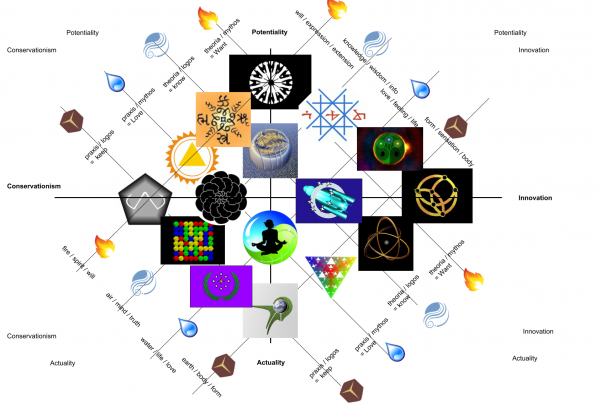 Image from Avengium | |
| The Great Hexadeximal (Diagonal version) | |
The Sixteen Nodes
The Order: Negentropy Alliance. Fire/spirit/will. and Praxis/logos. Colloquially referred to as "Keep spirit". This archetype is focused on the abstract. But eir methods are practical and conservative. E want to understand the spirit to keep it forever.The Radiant Axii [Empiricist]: Solar Dominion. Fire / spirit / will and Praxis / mythos. Colloquial: "Love spirit". This archetype like the field of spirit. It has a strong will and like to promote it. E like to be practical but also like to explore the beauty of the soul.
The Ashram (temple): Sophic League. Fire / spirit / will and Theoria/logos. Colloquial: "Know Spirit". This archetype like to learn about the soul. It has wisdom. E make theories and concepts to express their understanding of the spirit.
The Bindu (devotional dot): Keter Dominion. Fire / spirit / will and Theoria/mythos. Colloquial: "Want spirit". This archetype is the pursuer of the abstract. E favor intellect and spirit but also want to embrace the mystery beyond their current state.
The Grid (Modulist): Metasoft Version Tree. Air / mind / truth / knowledge. and Praxis/logos. Colloquial: "Keep mind". This archetype is rationalist and practical. Want to systematize all under a comprehensive protocol.
The Parliament (Diplomat): Communion of Worlds. Air / mind / truth / knowledge, and Praxis / mythos. Colloquial: "Love Mind". This archetype is practical and likes to immerse itself in understanding their environment and other sophonts. Likes the psychology and social relationships. Loves to discover.
The Network: Cyberian Network. Air / mind / truth / knowledge. and Theoria/logos. Colloquial: "Know Mind". This archetype theorize about the mind. E learn to have a mental map. E is flexible.
The Possibilities: Technorapture Hypernation. Air / mind / truth / knowledge. and Theoria/mythos. Colloquially: "Want mind". This archetype likes to play with abstractions, not about rationality. Likes to experiment. Pursue the mystery beyond many different mindtypes.
The Spectacle (indulgist): Terragen Federation. Water / life / love / feeling. Praxis/logos. Colloquially: "Keep life". This archetype likes to order and organize eir environment to ease the daily life of living beings.
The Sensitive Chaos (organicist): Zoeific Biopolity. Water / life / love / feeling. And Praxis/Mythos. Colloquially: "Love life". This archetype likes the dynamism of life. It has a practical attitude and enjoy the variety of beings and experiences although sometimes these are unpredictable.
The Marketplace (trader): Fomalhaut Acquisition Society. Water / life / love / feeling. Theoria/logos. Colloquially: "Know life". This archetype has a rational mind and want to catalog the experiences and beings to know them better.
The Transformations: Red Star 'M'pire. Water / life / love / feeling. Theoria/mythos. Colloquially: "Want life". This archetype loves to change. E tries to pursue the essence of life through change.
The Great Round: Caretaker Gods. Earth / body / form / sensation. Praxis/logos. Colloquialy: "keep body". This archetype wants to preserve the physical reality and all their development is focused to this end.
The Garden: Utopia Sphere. Earth / body / form / sensation. Praxis/mythos. Colloquially: "Love body". This archetype loves the physical world, the physical sensations and the dynamism and mystery of life.
The Megastructure (builder): Mutual Progress Association. Earth / body / form / sensation. Theoria/logos. Colloquially: "Know body". This archetype is rational and likes to theorize. They like the material world and likes to build from the ground up.
The Tower (entrepreneur): Non Coercive Zones. Earth / body / form / sensation. Theoria/mythos. Colloquially: "Want body". This archetype likes the material world. E likes to innovate and follow the dynamics of commerce. E will analyze the pros & cons and have different paths for eir objectives.
Four archetypes (The Bindu, The Network, The Sensitive Chaos (organicist) and the Great Round) are called redundant archetypes (or focused archetypes) because they have equivalent attributes on both axis. Two fire, two air, two water and two earth respectively.
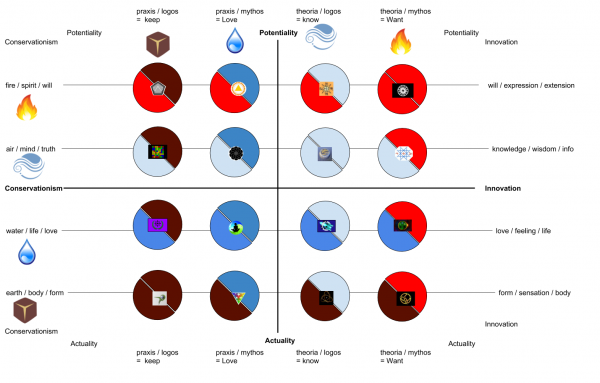 Image from Avengium | |
| The Great Hexadeximal (Elemental version) | |
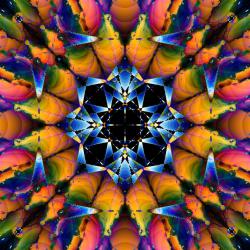 Image from John B |
Related Articles
- Archailect Identity Theory - Text by M. Alan Kazlev
Doctrine that an archailect's avatars or epiphanies to lower toposophics represent a true and authentic (if scaled down) expression of the archailect. Contrast with Instrumentalism. - Archailectology, Schools of
- Archailects
- Archailectual Mysticism
- Archaitheocracy
- Archaitheology
- Binah (The Great Architect)
- Chesed (Archailect)
- Cyberhermeticism
- Kabbalah
- Keter (archailect)
- Malkuth (toposophy)
- Maya (The Lady of Illusions)
- Neohermeticism
- Netzah (toposophy) - Text by M. Alan Kazlev
In the Keterist system of toposophy, corresponds to the fourth primary singularity or toposophic empire. The term was first applied in this context by the early Keterist Cyberhermetics. - Sephirah
- Yetzirah - Text by M. Alan Kazlev
The World of Formation - in traditional Kabbalah and Hermeticism the third of the fourth universes that emanated from the En Sof. The spiritual world immediately behind the physical universe.
Appears in Topics
Development Notes
Text by Avengium
Original article by M. Alan Kazlev; revised 27 September 2018
Initially published on 13 July 2001.
Original article by M. Alan Kazlev; revised 27 September 2018
Initially published on 13 July 2001.
